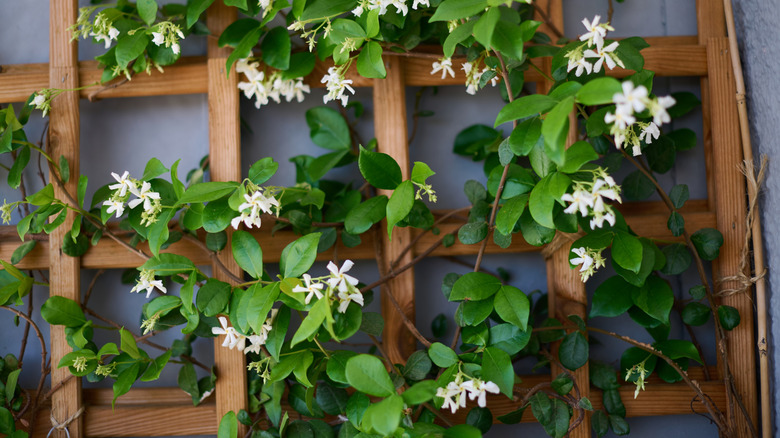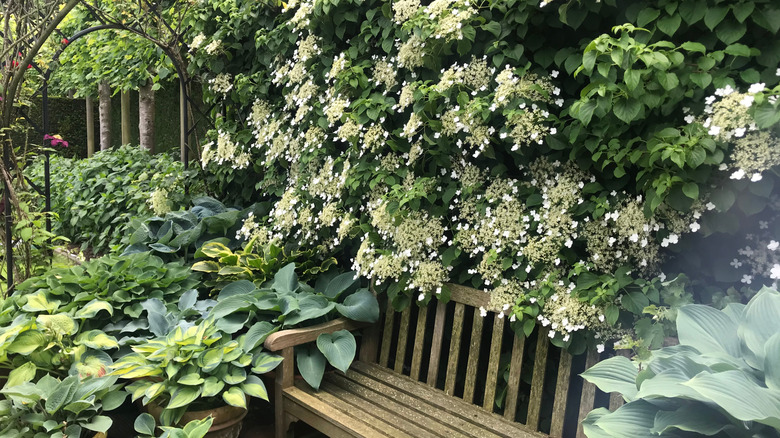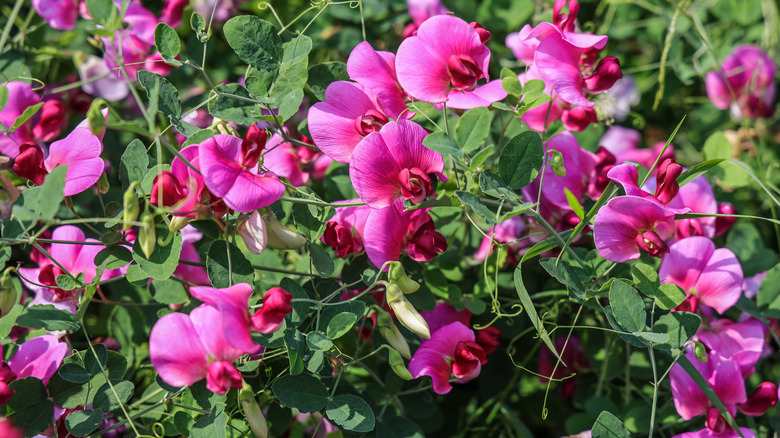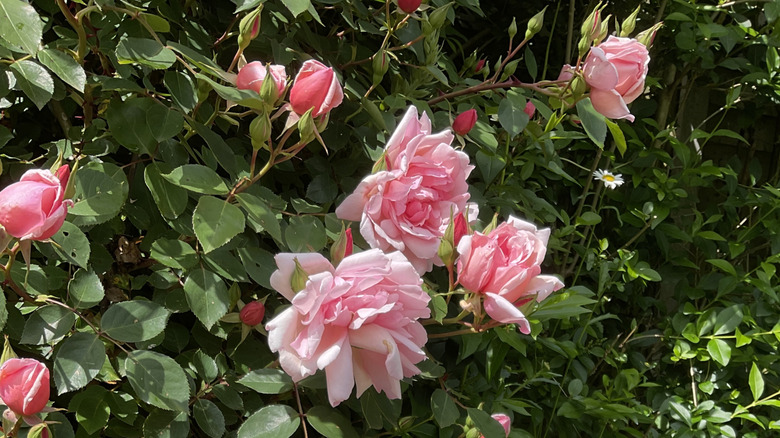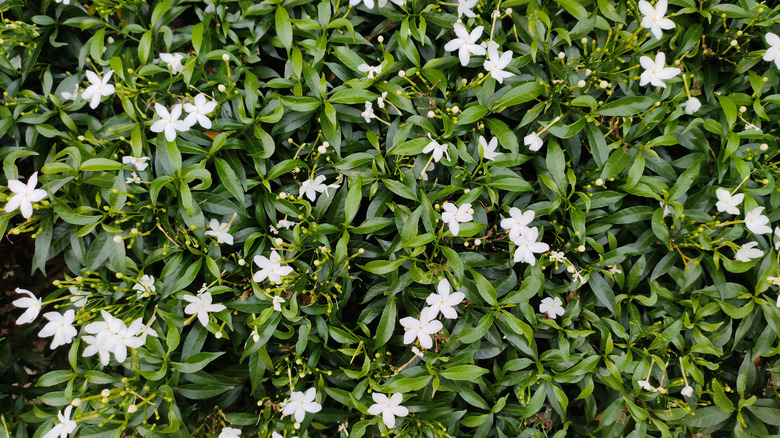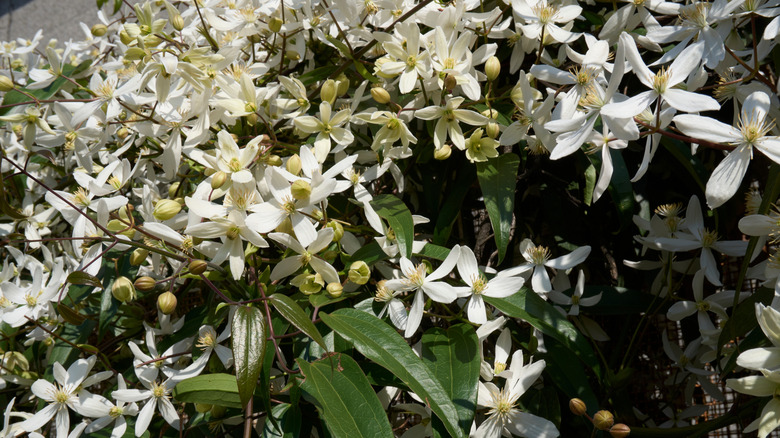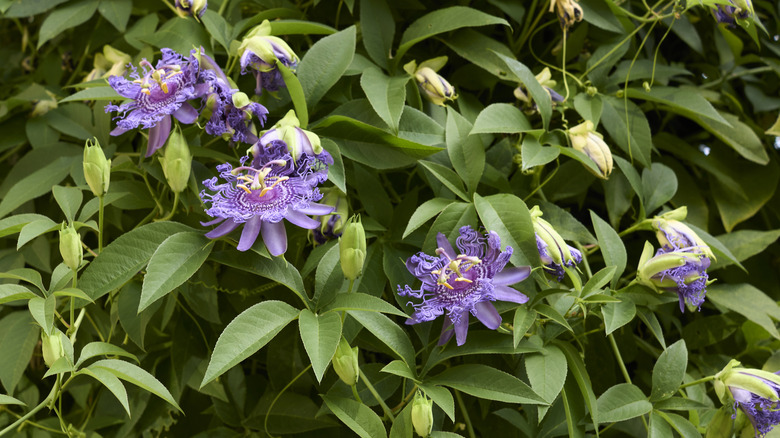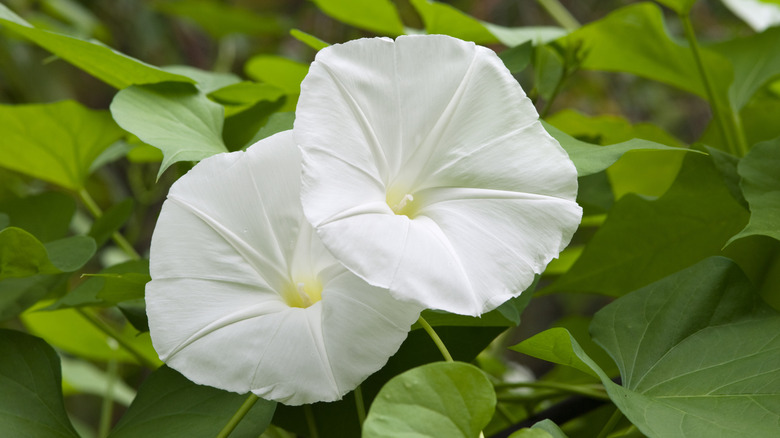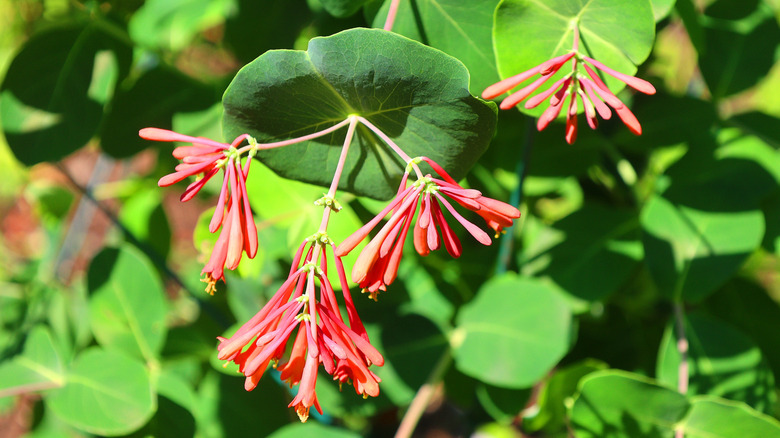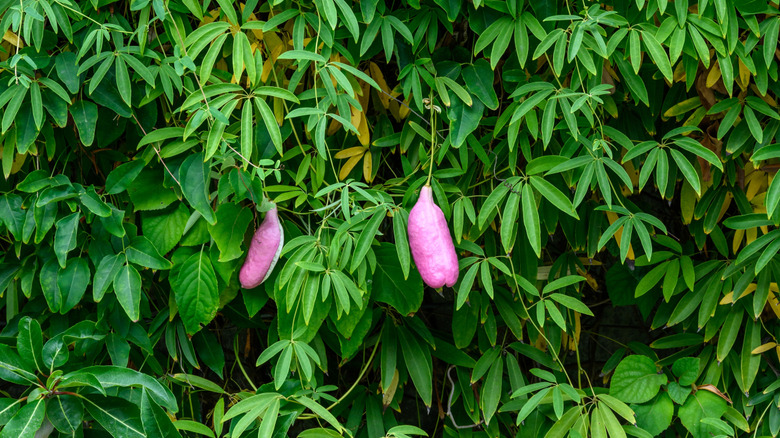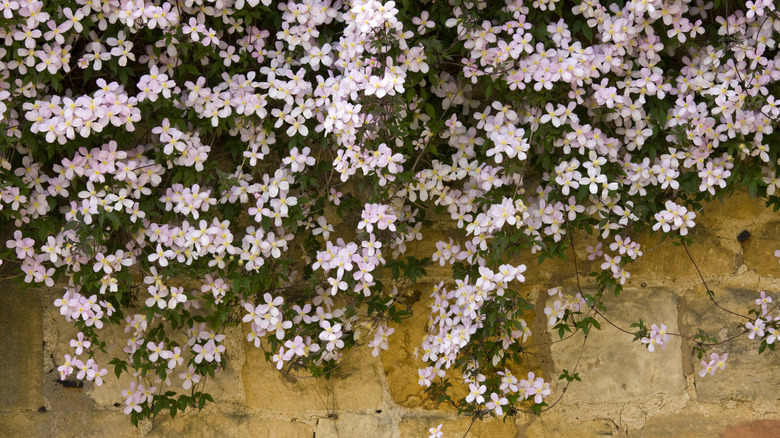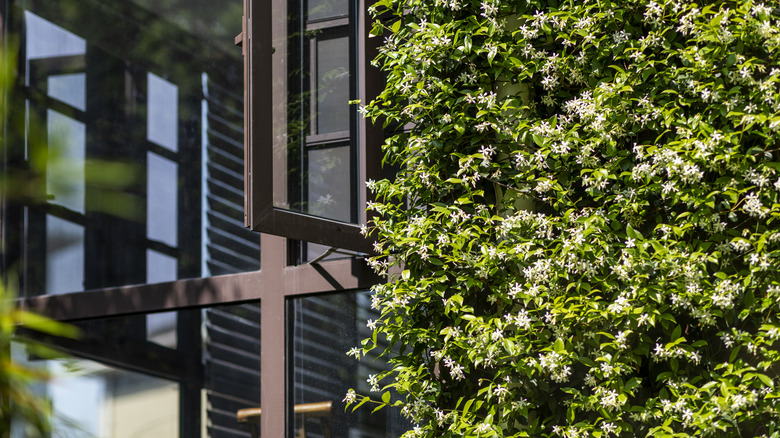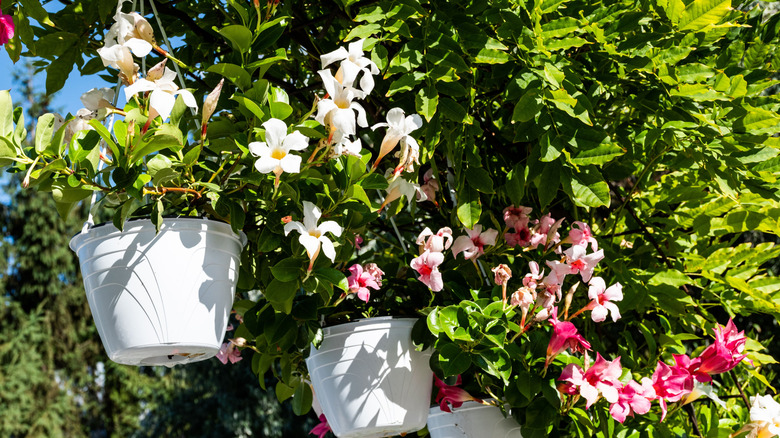12 Climbing Plants That Will Fill Your Garden With Heavenly Scents
In our busy lives, it can be difficult to find time to stop and smell the flowers, so try streamlining the process by bringing a flower's scent to you. This is easily done by filling your garden with especially fragrant blossoms. Having an aromatic garden is good for both you and the environment, since the soothing floral scents can help ease anxiety while simultaneously providing a nectar source for helpful pollinators like bees, which is good for all kinds of plants. Almost any splendidly-scented flower would make a good addition to your garden, but if you want to make a visual and olfactory impression, opt for climbing flowers that can wrap around trellises, paint walls, and cover pagodas.
Aromatic climbing flowers typically take up quite a bit of space, and can therefore imbue more of your outdoor area with their scents. Jasmine and clematis are some of the most popular types of flowers in this ilk, but there are plenty of other varieties that can suit a wide range of climates and perfume preferences.
Climbing hydrangea
Climbing hydrangea (Hydrangea anomala) has delicate, ivory flowers and broad, heart-shaped leaves that give gardens a whimsical, rustic feel. It thrives in zones 4 to 8, where it does best in full or partial sun (unless it's faced with extremely hot conditions, in which case it can take more shade). These climbing blooms also need regular watering and nutrient-rich soil. With proper care, countless flowers with a classic floral aroma emerge in summer. Just be aware that these vines can grow very heavy, and need to be set up somewhere that can hold them for a long time.
Sweet pea
This dainty flower didn't get its name from its warm personality; sweet peas (Lathyrus odoratus) have a naturally sweet aroma that's reminiscent of honey and citrus. If a strong scent is your top priority, look for heirloom sweet pea varieties since they are typically more intense. Sweet peas are adaptable and grow in hardiness zones 3 through 8, but need plenty of climbing support (at least 6 feet) to thrive. Despite their sweet exterior, these cute blooms are toxic when ingested.
Albertine roses
Albertine Roses (Rosa 'Albertine') are a rambling rose variety with large, deep pink flowers that you can grow along practically any structure. The Albertine is for those who want to be bathed in floral fragrance. Its scent is intensely rich and sweet, with notes of fruit. These roses stand up well against heat and drought, so if you're in zones 5 through 9, a trellis full of Albertines may be just what your garden needs. If you want to incorporate even more roses, check out these rose varieties that will make your garden smell heavenly.
Common jasmine
Also known as true jasmine (Jasminum officinale), common jasmine is a deep green vine with delicate white flowers and a sweet, fresh scent. Jasmine does best in warmer climates (zone 7 and above). Don't fret if you live somewhere colder — with proper care, an indoor jasmine plant can fill your entire home with its iconic aroma. This rapidly growing vine takes up a lot of space, and its thick, luscious leaves make it well-suited to act as a privacy screen as long as you take time to regularly cut back any rogue stems.
Evergreen clematis
Evergreen clematis is a group of flowers that includes Clematis cirrhosa and Clematis armandii. While both have a pleasant scent, the latter is an especially popular choice when fragrance is the focus. Clematis armandii, like 'Apple Blossom,' is a great option for those who don't like overly floral scents due to its light, nutty aroma. These lacy flowers do best in hot climates and are fast and easy to grow, making them ideal for quickly covering walls or trellises. However, Clematis armandii is toxic to pets, so be sure it's not accessible to your furry friends.
Passionflower
Passionflower (Passiflora incarnata), also known as apricot vine or maypop, is a striking perennial that emits a light, floral fragrance with earthy, sweet notes. Hardy in zones 5 to 9, it's a vigorous vine that needs plenty of space to climb. It thrives in a range of soil conditions, full sun, and regular watering. While not invasive, it can be an aggressive grower and therefore benefits from regular pruning. Luckily, care for this plant is easily rewarded with bold foliage, unique flowers, and aromatic, egg-shaped fruits in late summer. Beware that passionflower foliage is toxic to humans when ingested.
Moonflower
Whether you're a night owl or prefer dramatic blooms, moonflowers (Ipomea alba) will make an elegant addition to your garden. This tropical plant is hardy in the warm environments of zones 9 to 12, and is famous for only blooming once the sun has gone down. That means that during the evening, your yard will be filled with the calming scents of jasmine and vanilla. Even though it only flowers at night, this vine still needs full sun during the day. If a dramatic nighttime garden sounds appealing, stock up on these other stunning plants that bloom at night.
Honeysuckle
It's important to choose plants that are well-suited to your property. If your yard is full of shady spots, consider filling them with a climbing variety of honeysuckle (Lonicera periclymenum). With its roots safely in the shade, honeysuckle can stretch and climb towards the sun. By helping it along with twine, honeysuckle can effortlessly weave through fences, pagodas, and other shrubs. Honeysuckle has a super sweet scent that intensifies in the evening and attracts all manner of pollinators. This sweet bloom is also very hardy and can be grown in zones 4 through 9.
Sausage vine
Fortunately for all of us, sausage vine (Holboellia coriacea) does not actually smell like sausages. Instead, it has a fruity, citrus scent that will make your entire outdoor area feel fresh and welcoming. Sausage vines have vibrant, substantial leaves and can produce small, pale purple, drooping flowers with enough sunlight. The flowers are what actually produce an odor, so if you want your yard to smell like lemons and melons, plant them in the sun. Like many other vines, Holboellia coriacea can quickly become overgrown, so be sure to prune it before every growing season.
Mountain clematis
Another robust, fragrant vine is mountain clematis (Clematis montana). In Hardiness zones 6 through 9, this plant can easily surpass 30 feet in length and cover entire walls in no time. It emits a captivating scent with notes of vanilla and almond, and has smaller blooms than other climbing plants, creating some visual interest when paired with other vines. For an especially aromatic variety, look for 'Rubens' Clematis montana. Clematis are deciduous plants, which means they lose their leaves during the off-season, making them less ideal for creating privacy walls.
Star jasmine
For a climbing flower that will keep its leaves all year long, look no further than star jasmine (Trachelospermum jasminoides). Star jasmine's scent has more depth than common jasmine, with vanilla notes and an intense sweetness. Maxing out at about 6 by 6 feet, it's not as big as some other vines on this list, making it a better choice for low walls or shrubs. It's also the perfect choice for added privacy along your backyard fence. Star jasmine is as hardy as other jasmine varieties and needs plenty of sun and water to thrive.
Chilean jasmine
The Chilean jasmine (Mandevilla laxa) should be the plant of choice for anyone who wants a vine with flowers that look as magnificent as they smell. Its immense white flowers and rich vanilla scent make this climber a true delight to the senses. They prefer to be in hot climates like zones 9 to 11, where they can reach over 20 feet tall. With enough sun and water, Chilean jasmine will make a wonderful addition to any garden. Additionally, jasmine plants grow well when paired with other climbing flowers like clematis.
